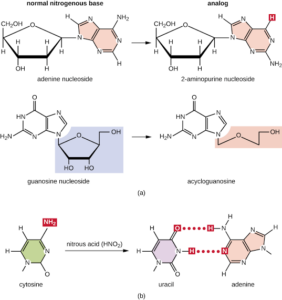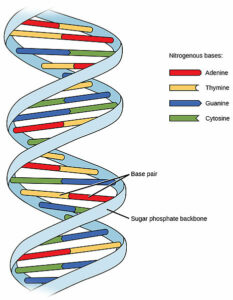Nucleotides are the basic monomeric unit of any nucleic acid, consisting of a pentose sugar molecule, one of the four nitrogenous bases and phosphate groups. Here we discuss about nucleotide examples and their related facts.
According to the number of phosphate groups, we can differentiate the nucleotides into three groups.
The nucleotide examples consisting only one phosphate group are-
Adenosine monophosphate (AMP)
Adenosine monophosphate (AMP) is the basic monomeric unit of RNA. It is also known as 5′-adenylic acid. The molecule is basically an ester of nucleoside adenosine and phosphoric acid, consisting of one phosphate group, a pentose sugar ribose and nitrogenous base adenine.It can be converted into ADP and ATP through the phosphorylation process. Due to different catabolic pathways, it can also convert into the uric acid in the body.
Guanosine monophosphate (GMP)
Guanosine monophosphate (GMP) is a basic nucleotide monomeric unit of RNA.It is also referred to as 5′-guanylic acid. GMP has a five-carbon ribose sugar molecule, a guanine nitrogenous base and only one phosphate group in it. GMP produces different salts,which can be used as food additives.
Cytidine monophosphate (CMP)
Cytidine monophosphate (CMP) is also a ribonucleotide monomeric unit of RNA. CMP is a ester of phosphoric acid with the nucleoside cytidine, consisting of a five carbon ribose sugar molecule, a nitrogenous base cytosine and a phosphate group. It can be converted into cytidine diphosphate (CDP) and cytidine triphosphate (CTP) by phosphorylation process.
Uridine monophosphate (UMP)
Uridine monophosphate (UMP) is a ribonucleoside monophosphate, one of the basic monomeric units of RNA. It is also known as 5′-uridylic acid, consisting of a pentose sugar molecule (ribose sugar), a nitrogenous base uracil and a phosphate group. It is an ester molecule of nucleoside uridine and phosphoric acid. It plays a significant role in brain development of an individual, it is mostly catabolized in the liver and gastrointestinal tract of an individual.
Cyclic adenosine monophosphate (cAMP)
Cyclic adenosine monophosphate (cAMP) is a derivative of ATP. It is a second messenger, plays very crucial roles in cell signaling pathways.
Cyclic guanosine monophosphate (cGMP)
Cyclic guanosine monophosphate (cGMP) is a cyclic derivative of GTP, used as an ion channel conductance regulator. The cGTP is a common second messenger in the phototransduction procedure in the eyes. Cellular apoptosis is also regulated by cyclic guanosine monophosphate.
Cyclic cytidine monophosphate (cCMP)
Cyclic cytidine monophosphate (cCMP) is a cyclic nucleotide derived from CTP or Cytidine triphosphate. It also serves as a cellular messenger in eukaryotic cells, but most of its activities remain unknown.
Cyclic uridine monophosphate (cUMP)
Cyclic uridine monophosphate (cUMP)is a cyclic nucleotide having nitrogenous base uracil. It is also a cellular messenger molecule in mammalian cells, but most of its activities remain unknown now.
Deoxyadenosine monophosphate (dAMP)
Deoxyadenosine monophosphate (dAMP) is a common derivative of AMP, used as a monomeric unit of DNA. It has a deoxyribose sugar, a nitrogenous base adenine and only one phosphate group in its structure.
Deoxy guanosine monophosphate (dGMP)
Deoxy guanosine monophosphate (dGMP) or deoxyguanylic acid is a common derivative of GMP. It contains a deoxyribose sugar, a nitrogenous base guanine and only one phosphate group in it. It is used as a basic monomeric unit of DNA synthesis.
Deoxycytidine monophosphate (dCMP)
Deoxycytidine monophosphate (dCMP) is one of the four deoxyribose monophosphate nucleotides, used in DNA synthesis. It contains a deoxyribose sugar, a nitrogenous base cytosine and only one phosphate group in its structure. It is a derivative of a common CMP molecule.
(Deoxy)thymidine monophosphate (dTMP)
(Deoxy) thymidine monophosphate (dTMP) is a monomeric unit of DNA. It contains a deoxyribose sugar, a nitrogenous base thymine and a phosphate group in its structure. It is only found with the deoxyribose sugar, hence can not be used in RNA synthesis. It is an ester of phosphoric acid with a nucleoside thymidine. The thymidine monophosphate mostly doesn’t contain the prefix “deoxy” with its name.

Nucleotide Examples from Wikimedia Commons
The nucleotide examples consisting two phosphate groups are-
Adenosine diphosphate (ADP)
Adenosine diphosphate(ADP) is a nucleotide mostly used to store or transfer energy. It has a five-carbon ribose sugar, a nitrogenous base adenine and two phosphate groups in it. It is associated with several cellular activities like respiration, platelet activation, etc. It plays a crucial role in glycolysis, citric acid cycle and oxidative phosphorylation in cellular respiration.
Guanosine diphosphate (GDP)
Guanosine diphosphate (GDP) is a nucleoside diphosphate molecule, mostly essential in the signal transduction mechanism of cells. It consists of a ribose pentose sugar, a nitrogenous base guanine and a pyrophosphoric group (two phosphate atoms). GDP can be convert into GTP.
Cytidine diphosphate (CDP)
Cytidine diphosphate (CDP) is a nucleoside diphosphate, which serves as a carrier molecule during phospholipid synthesis. It has a ribose pentose sugar, a pyrimidine base cytosine and pyrophosphate group in it. During the phospholipids synthesis process cytidine diphosphate plays an important role in prokaryotic and eukaryotic cells.
Uridine diphosphate (UDP)
Uridine diphosphate (UDP) is a nucleoside diphosphate having pyrimidine base uracil, essential for various metabolic and excretory activities. It contains a five-carbon ribose sugar, a nitrogenous base uracil and pyrophosphate group. In the glycogenesis process uridine diphosphate serves as an enzyme and facilitates various metabolic processes.
Deoxyadenosine diphosphate (dADP)
Deoxyadenosine diphosphate (dADP) is a nucleoside diphosphate derived from common ADP. It comprises a deoxyribose sugar, a purine base adenine and a pyrophosphate group. dADP is present in different eukaryotic cells and plays an essential role in the purine synthesis process.
Deoxyguanosine diphosphate (dGDP)
Deoxyguanosine diphosphate (dGDP) is a nucleoside diphosphate having purine base guanine. It is also known as 2′-Deoxyguanosine 5′-diphosphate, comprises a deoxyribose sugar, a purine base guanine and two phosphate units in its structure. It is a metabolite, which helps in the purine synthesis process.
Deoxycytidine diphosphate (dCDP)
Deoxycytidine diphosphate (dCDP) is a nucleoside having pyrimidine base cytosine. It is a common derivative of CTP. It comprises a deoxyribose sugar, a pyrimidine base cytosine and two phosphate units. It is also known as2′-deoxycytidine 5′-diphosphate. It plays some roles as cellular metabolite in humans and yeast (saccharomyces cerevisiae) cells.
(Deoxy)thymidine diphosphate (dTDP)
Dhh triphosphate (TTP). It comprises a deoxyribose sugar, a pyrimidine base thymine and two phosphate units in its structure. Unlike other deoxyribonucleotides, the thymidine diphosphate doesn’t contain the prefix “deoxy” mostly.

Nucleotide Examples in DNA from Wikimedia Commons
To know about purine metabolism read our article on Purine metabolism | Importance in human physiology
The nucleotide examples consisting three phosphate groups are-
Adenosine triphosphate (ATP)
Adenosine triphosphate (ATP) is a nucleoside triphosphate, often called the energy currency of a cell. It comprises a ribose pentose sugar, a nitrogenous base adenine and three phosphate units. During energy transfer it converts into ADP and AMP by hydrolysis process. It is one of the most important nucleotides in every living organism, involved in various activities like intracellular signal transduction, extracellular signaling, amino acid activation, nucleic acid synthesis, etc.
Guanosine triphosphate (GTP)
Guanosine triphosphate (GTP) is a nucleoside triphosphate having purine base guanine. It serves as an energy source of cells and also stimulates signal transduction pathways. It contains a ribose pentose sugar, a nitrogenous base guanine and three phosphate units. It is a very essential nucleotide, used in the RNA transcription process. It also plays an important role in several metabolic processes such as gluconeogenesis, protein synthesis, etc.
Cytidine triphosphate (CTP)
Cytidine triphosphate (CTP) is a nucleoside triphosphate, that means it has a ribose pentose sugar moiety, a pyrimidine base cytosine and three phosphate groups. Like ATP and GTP, it also serves as an energy source for cells. During glycerophospholipids and glycosylation of proteins the CTP acts as a coenzyme in different cells.
Uridine triphosphate (UTP)
Uridine triphosphate (UTP) is a nucleoside triphosphate having pyrimidine base uracil. It is composed of a five-carbon ribose sugar, a nitrogenous base uracil and three phosphate units in its structure. It is also used as an energy source of cells, involved in cell signaling and protein activation processes. It is mostly used in RNA transcription.
Deoxyadenosine triphosphate (dATP)
Deoxyadenosine triphosphate (dATP) is a nucleoside triphosphate, mostly used as energy currency of a cell. It comprises a deoxyribose sugar, a nitrogenous base adenine and three phosphate units. It plays a crucial role in DNA synthesis. It serves as an energy source of cells, transferring energy during different metabolic processes.
Deoxyguanosine triphosphate (dGTP)
Deoxyguanosine triphosphate (dGTP) is a nucleoside triphosphate, having purine base guanine. It is composed of a deoxyribose sugar, a purine base guanine and three phosphate units. It is used widely in polymerase chain reaction techniques.
Deoxycytidine triphosphate (dCTP)
Deoxycytidine triphosphate (dCTP) is a nucleoside triphosphate having nitrogenous base cytosine. It also serves as an energy source of cells, releasing energy during different metabolic processes through hydrolysis.
(Deoxy)thymidine triphosphate (dTTP)
Thymidine triphosphate (TTP) or dTTP is a nucleoside triphosphate having pyrimidine base thymine. It consists of a deoxyribose sugar, a nitrogenous base thymine and three phosphate units. It is mostly used during in vivo synthesis process of DNA while most of the uses of it remain unknown till now.
Uracil is only found in RNA, among all the nucleiotide examples and Thymine is only found in DNA among all the nucleiotide examples.
To know more about purines read our article on Purine | Its fundamental Structure
As a whole we can say that nucleotides are the most important part of a cell. Here we describe the nucleotide examples and about their exhausting features. Hope this article will be helpful to you.
Also Read:
- Exothermic examples
- Purine examples
- Molecules active transport examples
- Fluid friction examples
- Ecosyetm examples
- Monomer examples
- Centripetal force examples definition faq
- Harmonic oscillator examples
- Osmosis examples
- Refraction of waves examples

Hello, I am Piyali Das, pursuing my Post Graduation in Zoology from Calcutta University. I am very passionate on Academic Article writing. My aim is to explain complex things in simple way through my writings for the readers.